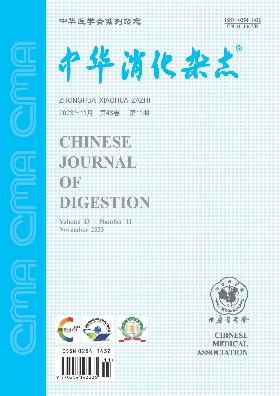Analysis of the clinical characteristics and related background diseases of 134 type 1 gastric neuroendocrine tumor
引用次数: 0
Abstract
Objective To explore the clinical characteristics and related background diseases of type 1 gastric neuroendocrine tumor (g-NET) and to provide reference information for clinical diagnosis and treatment. Methods From January 2011 to February 2019, at the First Affiliated Hospital of Sun Yat-sen University and China-Japan Friendship Hospital, the clinical features and related background diseases of type 1 g-NET patients (41 cases and 93 cases respectively)were retrospectively analyzed. The clinical symptoms, serological indicators, gastroscopic and pathological features, tumor location, metastasis and treatment, and concomitant diseases were statistically described. Results Among 134 patients with type 1 g-NET, there were 53 males (39.6%) and 81 females(60.4%); and the mean diagnosed age was (51±11) years (21 to 76 years). Main clinical manifestations were non-specific gastrointestinal symptoms. The mean level of serum chromogranin A was (237.7±176.8) μg/L. The endoscopic findings of 97.8% (131/134) of the patients were polypoid or protuberant lesions at gastric fundus or gastric body. And 75.0%(96/128) of the patients had multiple tumors.65.7%(88/134) of the patients had the tumors with the maximum diameter less than 1 cm (77.2%, 88/114) and the lesions mainly located in mucosa (59.8%, 52/87) and submucosa (40.2%, 35/87). The pathological classification of 79.3%(96/121) of the tumors was G1 grade and 20.7%(25/121) were G2 grade.The rate of local lymph node metastasis was 1.4%(1/73) and no distant metastasis was found. About 70.9% (95/134) of the patients received endoscopic treatment. Among the patients, 93.6%(103/110) of the patients had chronic atrophic gastritis confirmed by endoscopy or pathology, 45.6%(47/103) were confirmed by both endoscopy and pathology. Among the patients with chronic atrophy gastritis, serum gastrin levels of 93.2%(96/103)patients were twice higher than the upper limit of the normal value. The positive rates of anti-parietal cells antibody (PCA) and intrinsic factor (IFA) were 78.5%(73/93) and 51.9%(14/27), respectively.The incidence of Helicobacter pylori (H.pylori) infection was 28.1%(16/57). The incidence of autoimmune atrophy gastritis was 80.6%(75/93). The percentage of patients with deficiency of serum vitamin B12 and ferritin was 70.8%(63/89) and 30.7%(27/88), respectively. Patients with anemia accounted for 27.8%(25/90). The patients with microcytic anemia, normocyticanemia and macrocytic anemia were 28.0%(7/25), 56.0%(14/25) and 16.0%(4/25), respectively. 46.9%(45/96) of the patients had increased thyroid autoantibodies and 17.9%(17/95) patients had changes of thyroid hormone level. Conclusions Type 1 g-NET is more common in women and mainly caused by autoimmune atrophic gastritis. The level of serum PCA and IFA increase in more than half of the patients. And it is often accompanied by vitamin B12 deficiency and autoimmune thyroid disease. Key words: Type 1 gastric neuroendocrine tumor; Gastritis, atrophic; Autoantibodies; Clinical manifestations; Endoscopic characteristics134例1型胃神经内分泌肿瘤临床特点及相关背景疾病分析
目的探讨1型胃神经内分泌肿瘤(g-NET)的临床特点及相关背景病,为临床诊断和治疗提供参考资料。方法回顾性分析2011年1月至2019年2月中山大学第一附属医院和中日友好医院1型g-NET患者(41例和93例)的临床特点及相关背景疾病。对患者的临床症状、血清学指标、胃镜及病理特征、肿瘤部位、转移及治疗、伴发疾病进行统计学描述。结果134例1型g-NET患者中,男性53例(39.6%),女性81例(60.4%);平均诊断年龄为(51±11)岁(21 ~ 76岁)。主要临床表现为非特异性胃肠道症状。血清嗜铬粒蛋白A平均水平为(237.7±176.8)μg/L。97.8%(131/134)的患者在胃镜下表现为胃底或胃体息肉样或突起性病变。75.0%(96/128)的患者存在多发性肿瘤,65.7%(88/134)的患者肿瘤最大直径小于1 cm(77.2%, 88/114),病变主要位于粘膜(59.8%,52/87)和粘膜下层(40.2%,35/87)。G1级占79.3%(96/121),G2级占20.7%(25/121)。局部淋巴结转移率1.4%(1/73),未见远处转移。约70.9%(95/134)的患者接受了内镜治疗。93.6%(103/110)的患者经内镜或病理证实为慢性萎缩性胃炎,45.6%(47/103)的患者经内镜和病理均证实为慢性萎缩性胃炎。在慢性萎缩性胃炎患者中,93.2%(96/103)患者血清胃泌素水平高于正常值上限2倍。抗壁细胞抗体(PCA)和内在因子(IFA)阳性率分别为78.5%(73/93)和51.9%(14/27)。幽门螺杆菌感染发生率为28.1%(16/57)。自身免疫性萎缩性胃炎发生率为80.6%(75/93)。血清维生素B12和铁蛋白缺乏的比例分别为70.8%(63/89)和30.7%(27/88)。贫血患者占27.8%(25/90)。小细胞性贫血、正红细胞性贫血和巨细胞性贫血分别占28.0%(7/25)、56.0%(14/25)和16.0%(4/25)。46.9%(45/96)患者甲状腺自身抗体升高,17.9%(17/95)患者甲状腺激素水平改变。结论1型g-NET多见于女性,主要由自身免疫性萎缩性胃炎引起。半数以上患者血清PCA和IFA水平升高。它通常伴随着维生素B12缺乏症和自身免疫性甲状腺疾病。关键词:1型胃神经内分泌肿瘤;萎缩性胃炎;自身抗体;临床表现;内镜特点
本文章由计算机程序翻译,如有差异,请以英文原文为准。
求助全文
约1分钟内获得全文
求助全文

 求助内容:
求助内容: 应助结果提醒方式:
应助结果提醒方式:


